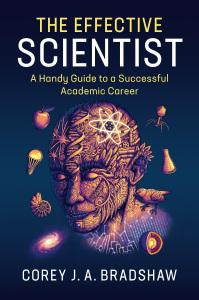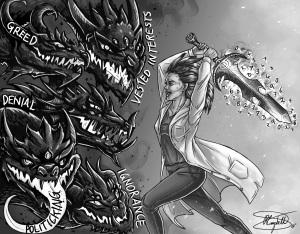 What is an effective scientist?
What is an effective scientist?
The more I have tried to answer this question, the more it has eluded me. Before I even venture an attempt, it is necessary to distinguish the more esoteric term ‘effective’ from the more pedestrian term ‘success’. Even ‘success’ can be defined and quantified in many different ways. Is the most successful scientist the one who publishes the most papers, gains the most citations, earns the most grant money, gives the most keynote addresses, lectures the most undergraduate students, supervises the most PhD students, appears on the most television shows, or the one whose results improves the most lives? The unfortunate and wholly unsatisfying answer to each of those components is ‘yes’, but neither is the answer restricted to the superlative of any one of those. What I mean here is that you need to do reasonably well (i.e., relative to your peers, at any rate) in most of these things if you want to be considered ‘successful’. The relative contribution of your performance in these components will vary from person to person, and from discipline to discipline, but most undeniably ‘successful’ scientists do well in many or most of these areas.
That’s the opening paragraph for my new book that has finally been release for sale today in the United Kingdom and Europe (the Australasian release is scheduled for 7 April, and 30 April for North America). Published by Cambridge University Press, The Effective Scientist. A Handy Guide to a Successful Academic Career is the culmination of many years of work on all the things an academic scientist today needs to know, but was never taught formally.
Several people have asked me why I decided to write this book, so a little history of its genesis is in order. I suppose my over-arching drive was to create something that I sincerely wish had existed when I was a young scientist just starting out on the academic career path. I was focussed on learning my science, and didn’t necessarily have any formal instruction in all the other varied duties I’d eventually be expected to do well, from how to write papers efficiently, to how to review properly, how to manage my grant money, how to organize and store my data, how to run a lab smoothly, how to get the most out of a conference, how to deal with the media, to how to engage in social media effectively (even though the latter didn’t really exist yet at the time) — all of these so-called ‘extra-curricular’ activities associated with an academic career were things I would eventually just have to learn as I went along. I’m sure you’ll agree, there has to be a better way than just muddling through one’s career picking up haphazard experience.
Of course, I made a lot of mistakes along the way. So, in an attempt to lessen the slope of this learning curve for young scientists today, I was convinced by a freelance publishing consultant working for Cambridge (Alan Crowden) to put together a book of all that accumulated experience (both bad and good). Alan did a fantastic job convincing one of my good friends, who also happens to be an editor at Cambridge (Dom Lewis), to take on the contract and voilà! The next thing I knew I was writing a book.
Thankfully for me I had at least the nucleus of several of the chapters already jotted down in the form of posts from this very blog (you can see what I mean by visiting the ‘Tips‘ page). None of these was suitable for direct use, so I had to polish, elaborate, expand, reference, and hone all of them. I also had to add many new topics about which I had never before blogged, but that I deemed important as subject material for the book.
 Once the thing started to take shape, I realised that many of the chapters should ideally be illustrated to some degree. Another fortuitous meeting brought me in contact with a wonderfully talented and generous artist/PhD student in my very university, the brilliant René Campbell. René is one of these rare people who is both a talented scientist and an accomplished artist (a combination I envy very much — check out her works here), and she agreed to take on a modestly paid contract to illustrate the book (18 cartoons — one of my favourites is included here on the left — plus the beautiful book cover you can see at the top of this post). René’s artwork really made the book come alive, and I hope that many scientists the world over will not only enjoy her work, but will also use the illustrations to help teach their own students and early-career scientist charges.
Once the thing started to take shape, I realised that many of the chapters should ideally be illustrated to some degree. Another fortuitous meeting brought me in contact with a wonderfully talented and generous artist/PhD student in my very university, the brilliant René Campbell. René is one of these rare people who is both a talented scientist and an accomplished artist (a combination I envy very much — check out her works here), and she agreed to take on a modestly paid contract to illustrate the book (18 cartoons — one of my favourites is included here on the left — plus the beautiful book cover you can see at the top of this post). René’s artwork really made the book come alive, and I hope that many scientists the world over will not only enjoy her work, but will also use the illustrations to help teach their own students and early-career scientist charges.
We’re planning a huge book launch in April in Adelaide (invitations to be sent out shortly), and I will also be signing copies at the CUP booth in Jyväskylä in Finland during the 5th European Congress of Conservation Biology in June this year. I also plan to attend the Ecological Society of Australia Annual Conference in Brisbane in November, and the British Ecological Society Annual Meeting in Birmingham this December where I will be signing copies. Other signing/promotional events might also occur this year, but I don’t yet have those details.
While the book’s contents are easily viewable here, I’ll take a moment now to explain its content and structure in general terms:
The book is divided into 25 chapters, and five ‘Parts’. Part I (8 chapters) is all about writing and publishing, include tips for efficient manuscript composition, good co-authorship politics, and even best-practice reviewing and editing. Part II (3 chapters) is about how to get better at your maths, and organize both your data and your research finances. Part III (6 chapters) is all about running a good laboratory, from diffusing conflicts, to encouraging diversity, to managing stress, and balancing work and life. Part IV (4 chapters) is the lighter side of academia, including the fun things like going to conferences and engaging with the media (both traditional and social). The final Part V (3 chapters) is more on the philosophy of why we do science in the first place, and it discusses touchy subjects like advocacy and application.
In short, I’m very proud of how the book turned out, and I’m grateful to all the people who helped or contributed, even in small ways. In addition to Alan, Dom, and René, I want to single out Noah Tate (Content Manager at Cambridge) for all his support and assistance. Please do read the full Acknowledgements though where I identify all those amazing people who help me make this happen. I sincerely hope that people find the book useful.
You can also purchase it in e-book or any other format on Amazon, and Google Books has a preview available for perusal.

